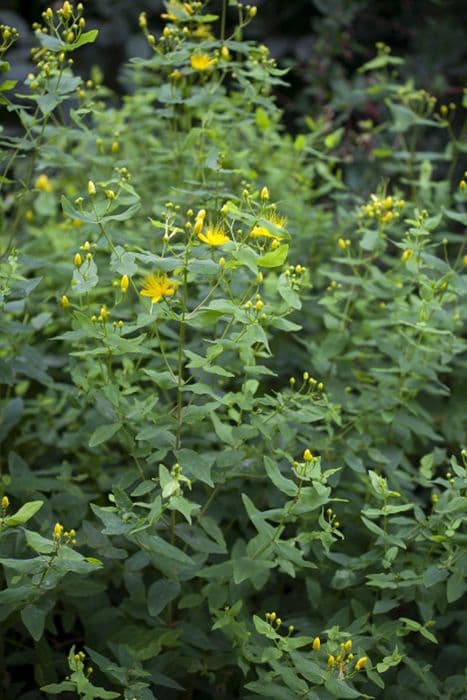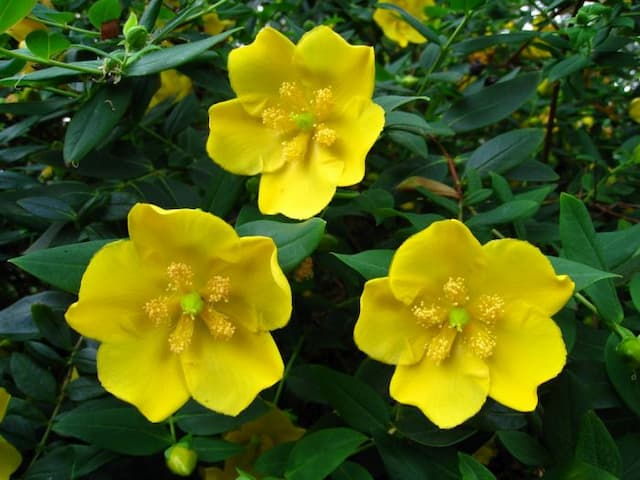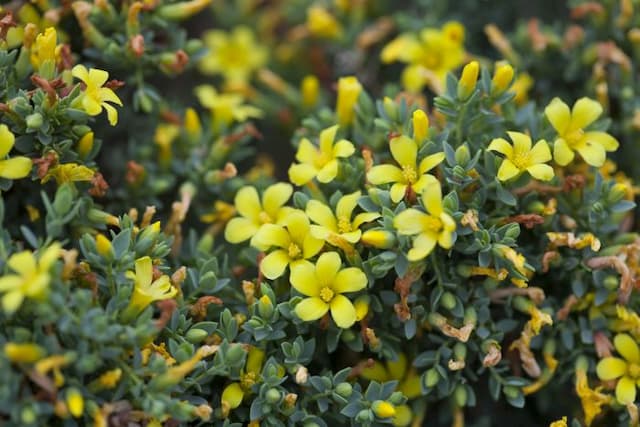Mount Olympus St John's wort Hypericum olympicum

ABOUT
H. olympicum is a dwarf, deciduous sub-shrub to 25cm in height, with erect stems crowded with small ovate, grey-green leaves. Flowers to 5cm in width, bright yellow, in small clusters
About this plant
 Names
NamesFamily
Hypericaceae
Synonyms
Olympic St. John's Wort, Mount Olympus St. John's Wort
Common names
Hypericum olympicum L.
 Characteristics
CharacteristicsLife cycle
Perennials
Foliage type
Evergreen
Color of leaves
Green
Flower color
Yellow
Height
1 foot (0.3 meters)
Spread
1 foot (0.3 meters)
Plant type
Shrub
Hardiness zones
5
Native area
Turkey
Benefits
 General Benefits
General Benefits- Ornamental value: Hypericum olympicum, commonly known as 'Olympic St. John's Wort,' is a decorative plant that can enhance the visual appeal of gardens and landscapes with its bright yellow flowers and compact, shrubby form.
- Drought resistance: It is well-suited to dry conditions and can thrive with minimal watering, making it ideal for xeriscaping and low-water gardens.
- Low maintenance: This plant generally requires little care once established, making it a convenient choice for gardeners with limited time.
- Pollinator attraction: The flowers of Olympic St. John's Wort attract various pollinators, including bees and butterflies, supporting local ecosystems.
- Ground cover: With its dense and spreading habit, it can be used effectively as ground cover to help suppress weeds and stabilize soil.
- Deer resistance: This plant is known to be resistant to browsing by deer, which is beneficial in areas where deer predation is a concern for gardeners.
- Adaptability: It can adapt to a range of soil types, although it prefers well-drained soils, making it versatile for different garden settings.
- Seasonal interest: Olympic St. John's Wort provides seasonal interest with its bright flowers during the summer and attractive seed pods and foliage in the fall.
 Medical Properties
Medical Properties- Antidepressant: Hypericum olympicum contains hyperforin and hypericin, which are thought to have antidepressant properties.
- Antimicrobial: The plant has been studied for its antimicrobial effects against various bacterial and fungal species.
- Anti-inflammatory: It may have anti-inflammatory properties, useful in reducing inflammation in various conditions.
- Wound healing: There are some indications that it may promote wound healing due to its antimicrobial and anti-inflammatory effects.
- Antioxidant: Hypericum olympicum may possess antioxidant properties, which can help in neutralizing harmful free radicals in the body.
 Air-purifying Qualities
Air-purifying QualitiesThis plant is not specifically known for air purifying qualities.
 Other Uses
Other Uses- As a ground cover in landscaping: Hypericum olympicum, with its dense growth and attractive yellow flowers, is used as a ground covering plant to fill spaces in gardens and landscaped areas.
- In creating natural dyes: The flowers and the leaves of Hypericum olympicum can be used to produce a range of natural dyes for textiles.
- Crafting floral arrangements: The bright, cheerful flowers of Hypericum olympicum make it a popular choice for fresh and dried flower arrangements.
- Erosion control: The plant's dense root system makes it useful for stabilizing soil in areas prone to erosion.
- Insect repellent in gardens: The scent of Hypericum olympicum can deter certain insects, making it a practical addition to gardens as a natural pest control strategy.
- Photography subject: The vibrant flowers and interesting foliage make Hypericum olympicum a favored subject for botanical and nature photographers.
- Education in plant biology: Hypericum olympicum is sometimes used in schools for teaching botany and illustrating plant development processes.
- Creating a wildlife habitat: The plant can provide shelter and food for insects and other small wildlife, contributing to biodiversity in the garden.
- Culinary decoration: While not for consumption, the flowers can be used to add visual appeal to dishes as a decorative element in gourmet cooking.
- Symbolism in cultural ceremonies: In some cultures, Hypericum olympicum may be used symbolically in ceremonies to represent joy or ward off evil spirits.
Interesting Facts
 Feng Shui
Feng ShuiThe plant Hypericum olympicum, commonly known as Olympic St. John's Wort, is not used in Feng Shui practice.
 Zodiac Sign Compitability
Zodiac Sign CompitabilityOlympic St. John's Wort is not used in astrology practice.
 Plant Symbolism
Plant Symbolism- Protection: Hypericum, also known as St. John's Wort, has historically been used to ward off evil spirits and negative energies. It was believed that hanging it in a window or above a door would keep malevolent forces at bay.
- Healing: The plant has medicinal properties and has been used to treat various ailments, symbolizing healing both physically and emotionally.
- Light and sun: The bright yellow flowers of St. John's Wort are often associated with sunlight and its life-giving energy, symbolizing vitality and positivity.
- Strength against adversity: Due to its hardy nature and ability to thrive in poor soil conditions, St. John's Wort can represent resilience and the ability to withstand hardships.
- Happiness and cheer: The sunny appearance of the plant's flowers is symbolic of happiness and is thought to bring joy and lift spirits.
 Water
WaterOlympic St. John's Wort prefers a moderate watering routine, where the soil is allowed to dry out slightly between waterings. In the growing season, typically water the plant once every week with about 16 to 32 ounces of water, depending on the size of the plant and the dryness of the soil. During winter months, reduce watering to every other week or less, as the plant enters a dormant period and requires less moisture. Be cautious not to overwater, as this can lead to root rot.
 Light
LightOlympic St. John's Wort thrives in full sun to partial shade. The best spot for the plant would be one where it receives at least six hours of direct sunlight daily. However, it can also tolerate light dappled shade, especially in regions with very hot summers.
 Temperature
TemperatureOlympic St. John's Wort is hardy and can tolerate a temperature range from approximately 50°F to 90°F. The ideal temperature conditions are between 60°F and 80°F for optimal growth. Extreme temperatures below 50°F could damage or kill the plant, while it can survive brief periods above 90°F if properly cared for.
 Pruning
PruningPrune Olympic St. John's Wort to shape the plant, remove dead or diseased wood, and encourage bushy growth. The best time for pruning is in early spring before new growth begins. Cut back about one-third of the old growth annually. This also helps maintain the plant's compact form and stimulates new, healthy shoots.
 Cleaning
CleaningAs needed
 Soil
SoilOlympic St. John's Wort prefers well-draining soil mixed with sand and peat to enhance drainage, with a pH of slightly acidic to neutral (6.0 to 7.0).
 Repotting
RepottingOlympic St. John's Wort should generally be repotted every 2 to 3 years to refresh the soil and accommodate growth.
 Humidity & Misting
Humidity & MistingOlympic St. John's Wort thrives best in an environment with moderate humidity, but it is fairly tolerant of varying humidity levels.
 Suitable locations
Suitable locationsIndoor
Place in bright, indirect light and avoid overwatering Olympic St. John's Wort.
Outdoor
Plant in full sun to partial shade and in well-drained soil.
Hardiness zone
5-8 USDA
 Life cycle
Life cycleHypericum olympicum, commonly known as Olympic St. John's Wort, begins its life cycle as a seed, which germinates in moist, well-drained soil under full sun to partial shade conditions. Once germinated, the seedling emerges and grows into a woody-based perennial, developing a dense, shrubby form with blue-green leaves. Throughout the summer, it produces numerous bright yellow flowers characterized by prominent stamens, which are attractive to various pollinators. After pollination, the flowers develop into capsules containing numerous tiny seeds. As the growing season ends, the plant enters a period of dormancy, with aerial parts dying back in areas with colder climates. The plant resumes growth in the spring, completing its life cycle by beginning the process of vegetative growth and reproduction annually.
 Propogation
PropogationPropogation time
Spring to Summer
Propogation: The most popular method of propagating Hypericum olympicum, commonly known as Olympic St. John's Wort, is through seed sowing. Seeds can be sown outdoors in either fall or spring. Sowing in the fall allows the cold winter to naturally stratify the seeds, breaking dormancy and preparing them for germination in the spring. When sowing in spring, it's usually recommended to first provide the seeds with a period of cold stratification in a refrigerator, maintaining them at 34-38 degrees Fahrenheit (1-3 degrees Celsius) for about six to eight weeks. This simulates the natural winter conditions and helps to achieve a higher germination rate. After stratifying, the seeds should be lightly covered with soil and kept moist until germination, which typically occurs in two to three weeks.









